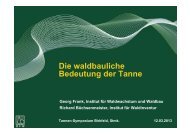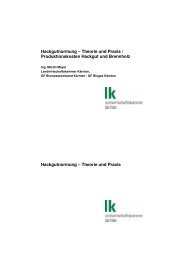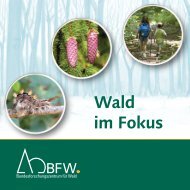Create successful ePaper yourself
Turn your PDF publications into a flip-book with our unique Google optimized e-Paper software.
Nutrient flow from the forest<br />
Life source for traditional<br />
Bhutanese agriculture<br />
Walter Roder, Karma Dorji, and Georg Gratzer
Tibet<br />
West Bengal Assam
Steep slopes<br />
High rainfall<br />
Poor parent material<br />
High erosion
In-organic fertilizers<br />
N 3.3 kg/ha<br />
P 0.7 kg/ha<br />
K 0.5 kg/ha
How is this possible?
Objectives of presentation<br />
describe methods used for gathering and<br />
transfer of nutrients<br />
describe nutrient sources<br />
describe techniques applied to enhance<br />
nutrient flow and availability
Materials and methods<br />
Published data<br />
Complementary investigations<br />
Litter raking area<br />
Tree species used for litter raking<br />
Nutrient content of materials collected form the<br />
forest<br />
Nutrient content of cattle manure
Cut and carry, weed<br />
Hay/silo<br />
Turnip/Radish<br />
Fodder tree<br />
Maize straw<br />
Rice straw<br />
Buckwheat straw<br />
1<br />
Forest grazing<br />
Grazing cropland<br />
Ara/chang residues<br />
Pangshing/Tsheri<br />
Improved pasture<br />
Common pasture<br />
Other crop by-product<br />
Fodder resources<br />
0 10 20 30 40 50<br />
Respondents (%)
Table 2: P-content in the soil, plant and manure from selected sites at elevation<br />
of 2600-2800 m dominated by blue pine (Pinus wallichiana) 1<br />
Site Soil Plant Manure<br />
Avail. (P<br />
mg/kg)<br />
P (%) P (%)<br />
Intensive used white<br />
clover<br />
11.6 0.18 0.60<br />
Cultivated fields<br />
7.1 0.20 0.51<br />
Forest/permanent<br />
grassland 1<br />
3.9 0.10 0.34<br />
1 The dominant herbaceous species included: Arundinella hookeri, Eragrostis nigra<br />
and Potentila spp.
Relationship between P in plant<br />
and P in dung<br />
P-content dung (%)<br />
1<br />
0.8<br />
0.6<br />
0.4<br />
0.2<br />
0<br />
0 0.05 0.1 0.15 0.2 0.25 0.3<br />
P-content plant (%)
Nutrient content in manure as influenced by herd<br />
(grazing) and date)<br />
N (%) P (%) K (%)<br />
Herd/location<br />
BS-farm 1.9 0.69 0.63<br />
Jalikhar 1.7 0.48 1.01<br />
Tangbi 1.4 0.32 0.90<br />
Chumey<br />
Anova<br />
1.5 0.29 0.79<br />
Herd/location
Nutrients transfered<br />
With 200-300’000<br />
animals about<br />
300-700 t P<br />
1500-3500 t N<br />
0.1-5 kg P/animal/year<br />
0.5-25 kg N/animal/yea
Sogshing = Life<br />
forest
Importance of sogshing in different regions of Bhutan<br />
Parameter Area<br />
(a/hh)<br />
Frequency<br />
(% hh)<br />
Area per<br />
crop land<br />
(ha/ha)<br />
Major tree species<br />
Wet subtropics 0.015 4.9 0.01 Schima wallichii<br />
Castanopsis indica<br />
Foot hills 0.067 19.2 0.07 Alnus nepalensis,<br />
Schima wallichii,<br />
Dry valleys<br />
High areas<br />
Quercus grifithii<br />
0.23 41.8 0.24 Chir pine, Quercus<br />
grifithii, Quercus<br />
lanata, Blue pine<br />
0.13 21.0 0.13 Blue pine, Quercus<br />
semecarpifolia
Nutrient content of major litter sources<br />
Litter type N P K<br />
Blue pine needles 0.81 0.05 0.27<br />
Blue pine needles & fern 0.51 0.06 0.27<br />
Fern 0.95 0.07 0.44<br />
Chir pine needles 0.74 0.08 0.22<br />
Oak 0.95 0.07 0.44<br />
Oak, fern and Puya 0.99 0.07 0.70
Soil cutting<br />
Fuel cutting/carrying<br />
Making mounds<br />
Burning<br />
Spreading soil<br />
Sowing<br />
Guarding<br />
Harvesting<br />
Threshing<br />
0 40 80 120 160<br />
Labor days
250-500 t of topsoil<br />
temperatures of 500 ° C<br />
150-400 labor days ha -1
Changes in soil parameters before and after burning<br />
Parameter Before<br />
burning<br />
After burning<br />
Soil pH 6.0 6.9<br />
Organic C (%) 3.3 0.8<br />
Total N (%) 0.17 0.08<br />
C:N ratio 22 11<br />
Available P 1) (mg kg -1 ) 1.0 6.8<br />
Available K 2) (mg kg -1 ) 34 69<br />
1) Extraction with NH4OAc+EDTA<br />
2) Extraction in CO2 saturated water
P and N added by blue pine biomass<br />
Content<br />
(%)<br />
Quantity<br />
(kg/ha)<br />
Biomass - 5700<br />
Phosphorus 0.103 6.1<br />
Nitrogen 0.94 55
Estimated quantities of P from the forest<br />
added to agricultural land<br />
Source Quantity<br />
(t/year)<br />
Ash from fire wood 100<br />
Cattle grazing in<br />
400<br />
forest<br />
Sogshing 200<br />
Grass fallow system 10<br />
In-organic fertilizer 153
The traditional methods are:<br />
Ingenious adaptation to given condition<br />
Harmful for forest<br />
Excellent example of organic agriculture<br />
Labor intensive methods poorly use resources<br />
Sustained use of local resources<br />
Harmful for environment


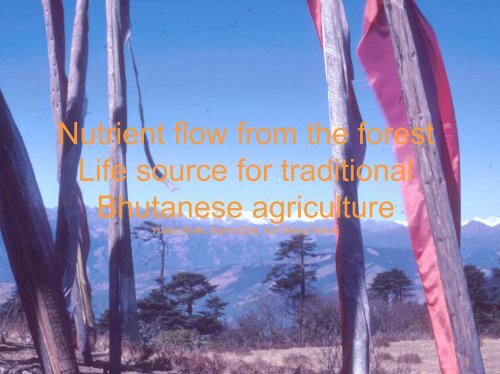

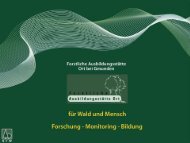
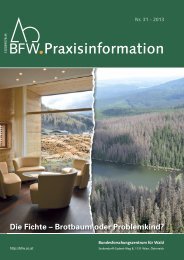

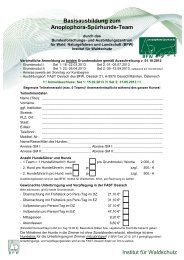
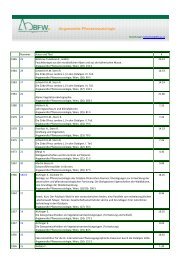
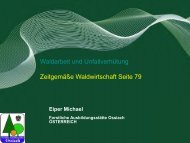
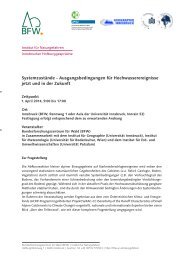

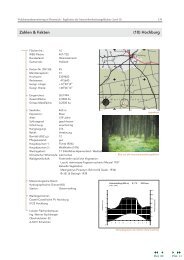

![pdf [7 MB] - BFW](https://img.yumpu.com/22350074/1/184x260/pdf-7-mb-bfw.jpg?quality=85)
